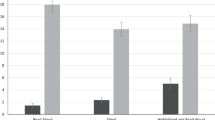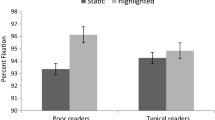Abstract
Environmental print is composed of words and contextual cues such as logos and pictures. The salience of the contextual cues may influence attention to words and thus the potential of environmental print in promoting early reading development. The present study explored this by presenting pre-readers (n = 20) and beginning readers (n = 16) with environmental print that was print-salient or picture-salient. Children’s visual attention to environmental print was measured using an eye tracker. Pre-readers were found to attend more to words in print-salient rather than picture-salient environmental print. In contrast, no difference in attention to words in print- or picture-salient environmental print was found in beginning readers. This suggests that although visual features of environmental print influence attention to words, children may preferentially attend to print according to their reading ability. Print-salient environmental print may be more beneficial for enhancing pre-readers’ visual attention to words, whereas print salience may be less important for beginning readers.



Similar content being viewed by others
Notes
The experimental protocol and item set was tested on a group of 22 skilled adult readers (M age = 23.32 years; SD = 7.56). A repeated measures MANOVA with item type (print-salient and picture-salient) as the repeated measures factor and log 10 time to first fixation, percent to total fixations, and percent of fixation duration as the eye tracking measures confirmed that the experimental manipulation influenced attention to the word area in the items, F(3, 25) = 5.98, p = 0.003, η 2p = 0.42.
References
Blair, R., & Savage, R. (2006). Name writing but not environmental print recognition is related to letter-sound knowledge and phonological awareness in pre-readers. Reading and Writing: An Interdisciplinary Journal, 19, 991–1016.
Clay, M. M. (2005). An observation survey of early literacy development. Auckland: Heinemann.
Ehri, L. C. (2005). Learning to read words: Theory, findings and issues. Scientific Studies of Reading, 9, 167–188.
Ehri, L. C. (2014). Orthographic mapping in the acquisition of sight word reading, spelling memory, and vocabulary learning. Scientific Studies of Reading, 18, 5–21.
Ehri, L. C., & Roberts, T. (2006). The roots of learning to read and write: Acquisition of letters and phonemic awareness. In S. B. Neuman & D. K. Dickinson (Eds.), Handbook of early literacy research (Vol. 2, pp. 113–130). New York: Guildford Press.
Elliott, M. C., & Firth, A. Y. (2009). The logMAR Kay picture test and the logMAR acuity test: A comparative study. Eye, 23, 85–88. doi:10.1038/sj.eye.6702990.
Evans, M. A., & Saint-Aubin, J. (2005). What children are looking at during shared story book reading: Evidence from eye movement monitoring. Psychological Science, 16, 913–920.
Frith, U. (1985). Beneath the surface of developmental dyslexia. In K. Patterson, J. Marshall, & M. Coltheart (Eds.), Surface dyslexia: Neuropsychological and cognitive studies of phonological reading (pp. 301–330). London: Erlbaum.
Horner, S. L. (2005). Categories of environmental print: All logos are not created equal. Early Childhood Education Journal, 33, 113–119.
Justice, L. M., & Lankford, C. (2002). Preschool children’s visual attention to print during story book reading: Pilot findings. Communication Disorders Quarterly, 24, 11–21.
Justice, L. M., Skibbe, L., Canning, A., & Lankford, C. (2005). Preschoolers, print and story books: An observational study using eye movement analysis. Journal of Research in Reading, 28, 229–243.
Kay Picture Test. (2013). Visual acuity test for children. Hertfordshire: Kay Pictures. http://www.kaypictures.co.uk
Liu, P. L. (2011). Environmental print: Research on Hong Kong children’s understanding of Chinese words. Asia-Pacific Journal of Research in Early Childhood Education, 5, 49–66.
Lomax, R. G., & McGee, L. M. (1987). Young children’s concepts about print and reading: Toward a model of word reading acquisition. Reading Research Quarterly, 22, 237–256.
Mason, J. M. (1980). When do children begin to read: An exploration of four year old children’s letter and word reading competencies. Reading Research Quarterly, 15, 203–227.
Masonheimer, P. E., Drum, P. A., & Ehri, L. C. (1984). Does environmental print identification lead children into word reading? Journal of Reading Behavior, 16, 257–271.
Neumann, M. M., Acosta, C., & Neumann, D. L. (2014). Young children’s visual attention to environmental print as measured by eye tracker analysis. Reading Research Quarterly, 49, 157–167. doi:10.1002/rrq.66.
Neumann, M. M., Hood, M., & Ford, R. (2013). Using environmental print to enhance emergent literacy and print motivation. Reading and Writing: An Interdisciplinary Journal, 26, 771–793. doi:10.1007/s11145-012-9390-7.
Neumann, M. M., Hood, M., Ford, R., & Neumann, D. L. (2011). The role of environmental print in emergent literacy. Journal of Early Childhood Literacy, 12, 231–258. doi:10.1177/1468798411417080.
Neumann, M. M., Hood, M., & Neumann, D. L. (2009). The scaffolding of emergent literacy skills in the home environment: A case study. Early Childhood Education Journal, 36, 313–319.
Neumann, M. M., & Neumann, D. L. (2010). Parental strategies to scaffold emergent writing skills in the pre-school child within the home environment. Early Years: An International Journal of Research and Development, 30, 79–94.
Oakes, L. M. (2010). Infancy guidelines for publishing eye-tracking data. Infancy, 15, 1–5.
Olsson, P. (2007). Real-time and offline filters for eye tracking. Unpublished master’s thesis. Stockholm: KTH Royal Institute of Technology.
Rayner, R. (1985). The role of eye movements in learning to read and reading disability. Remedial and Special Education, 6, 53–60.
Reutzel, D. R., Fawson, P. C., Young, J. R., Morrison, T. G., & Wilcox, B. (2003). Reading environmental print: What is the role of concepts about print in discriminating young readers’ responses? Reading Psychology, 24, 123–162.
Roy-Charland, A., Saint-Aubin, J., & Evans, M. A. (2007). Eye movements in shared book reading with children from kindergarten to Grade 4. Reading and Writing: An Interdisciplinary Journal, 20, 909–931.
Share, D. L., & Gur, T. (1999). How reading begins: A study of preschoolers’ print identification strategies. Cognition and Instruction, 17, 177–213.
Tobii Technology. (2011). Tobii TX300 eye tracker user manual. Danderyd: Tobii Technology.
Yannicopoulou, A. (2006). The influence of environmental print on preschoolers’ literacy development in a two-alphabet society. L1—Educational Studies in Language and Literature, 6, 1–12.
Author information
Authors and Affiliations
Corresponding author
Rights and permissions
About this article
Cite this article
Neumann, M.M., Summerfield, K. & Neumann, D.L. Visual attention to print-salient and picture-salient environmental print in young children. Read Writ 28, 423–437 (2015). https://doi.org/10.1007/s11145-014-9531-2
Published:
Issue Date:
DOI: https://doi.org/10.1007/s11145-014-9531-2




